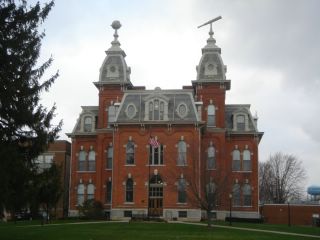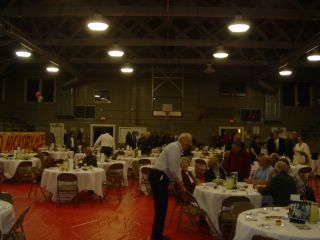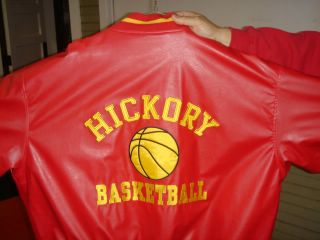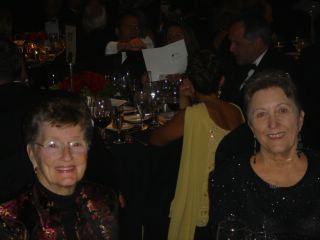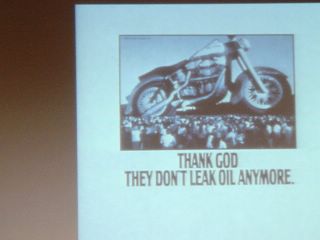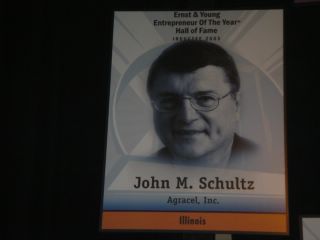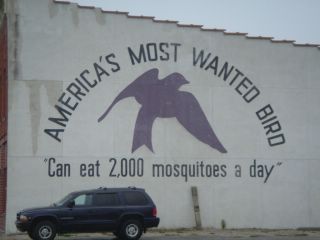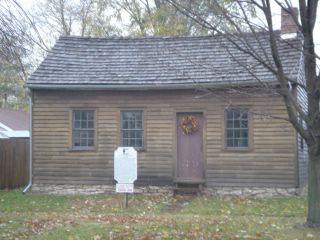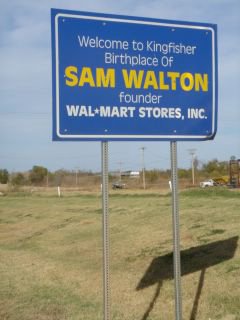“Lately Strong seems to be known as the town that has lost three major businesses in the last three years and we’d like to change that perspective,” said Eileen Miazga who owns EJ’s Market in Strong. So Miazga led an effort to turn things around in this NW ME town of 1,259. She and a small group of local citizens set up the Strong Area Business and Civic Alliance.
Strong’s economy has been dominated by lumber and the milling business. When those three mills closed their doors, many thought that would be the end of Strong. But, living up to its name, Miazga and others are working on highlighting the existing businesses in the town and developing new ones. They did an inventory of businesses in the town and as Miazga said, “I was amazed at the number that are here. I thought we maybe had 25.” But, the survey by the Alliance showed that they had 115 businesses, 8 civic organizations and 3 working farms. Many of those businesses started up after the mills shut their doors, demonstrating the entrepreneurial spirit of small towns.
Strong, ME is a great example of a town that isn’t going to shrivel up and die. Its people are strong minded and entrepreneurial. There are a lot of Strongs in the USA that are going to figure out how to prosper in this new century.
Wednesday, November 30, 2005
Tuesday, November 29, 2005
$100 Grows to $22 Million
“Little did anyone know, least of all class organizer Theodore Dann, that the New Castle High School graduating class of 1924’s decision to set up a small endowment with $100 would be the beginning of what is now the Henry Country Community Foundation,” is the start of a brief history of what is today a $22 million community foundation. Several other small funds were started as a result of that initial fund and by the late 1930s there were $25,000 in assets. By the 1950s the funds had grown to $75,000.
Today a giant oak of a community foundation has grown from that $100. With $22 million in assets, the foundation last year received gifts from 1,300 people totaling almost $700,000, gave out 404 grants totaling $650,000 and most importantly is positively altering the landscape in Henry County, IN (population 47,809).
Community Foundations are one of the best assets that a community can develop. I’ve seen numerous examples in my travels of the impact they can have.
What acorns are you planting today? Wouldn’t you love to be the Theodore Dann of your community?
Today a giant oak of a community foundation has grown from that $100. With $22 million in assets, the foundation last year received gifts from 1,300 people totaling almost $700,000, gave out 404 grants totaling $650,000 and most importantly is positively altering the landscape in Henry County, IN (population 47,809).
Community Foundations are one of the best assets that a community can develop. I’ve seen numerous examples in my travels of the impact they can have.
What acorns are you planting today? Wouldn’t you love to be the Theodore Dann of your community?
Monday, November 28, 2005
Jay Leno’s Goofiest Towns in America
At the Ernest and Young Entrepreneur of the Year competition, I got an autographed book from Jay Leno, which I read on the plane back home. I was pleased to see that he shares my fascination with strange named towns. Here are the ones that he identified, some of which I’ve already stumbled across, but also a few new ones.
Cheesequake, NJ
Monkey’s Eyebrow, AZ
Hygiene, CO
Yeehaw Junction, FL
Santa Claus, IN
Beebeetown, IA
Smileyberg, KS
Shoulderblade, KY
Hot Coffee, MS
Pumpkin Center, MO
Truth or Consequences, NM
Chocolate Bayou, TX
Humptulips, WA
Cheesequake, NJ
Monkey’s Eyebrow, AZ
Hygiene, CO
Yeehaw Junction, FL
Santa Claus, IN
Beebeetown, IA
Smileyberg, KS
Shoulderblade, KY
Hot Coffee, MS
Pumpkin Center, MO
Truth or Consequences, NM
Chocolate Bayou, TX
Humptulips, WA
Saturday, November 26, 2005
What If They’d Built that Lake?
“In the late 1980s we tried to build a 3,000 acre lake. We couldn’t put it together because we had a few people who wouldn’t sell their land. The whole idea just died.” Bill McCartney, head of ED for Pike County, IL told me during my recent visit.
After my talk in Pittsfield, I spoke with several local people about what the county might look like today if they had been able to build that lake. After seeing what has happened in similar areas with the impact of a lake, I’m convinced that Pittsfield and Pike County would be much more economically vibrant. There would be numerous second homes, more stores, and more employment. It’s too bad that they weren’t able to do that lake when brush land prices were only a couple of hundred dollars per acre. Today that same land would cost them thousands of dollars per acre.
I urged them to dig up the old plans for the lake and to try to resurrect it. Their kids and grandkids will thank them, if they do.
After my talk in Pittsfield, I spoke with several local people about what the county might look like today if they had been able to build that lake. After seeing what has happened in similar areas with the impact of a lake, I’m convinced that Pittsfield and Pike County would be much more economically vibrant. There would be numerous second homes, more stores, and more employment. It’s too bad that they weren’t able to do that lake when brush land prices were only a couple of hundred dollars per acre. Today that same land would cost them thousands of dollars per acre.
I urged them to dig up the old plans for the lake and to try to resurrect it. Their kids and grandkids will thank them, if they do.
Friday, November 25, 2005
Economic Impact of an Off-Road Park
“We hold one of only 26 Jeep Jamborees in the U. S. We host about 30 other events/year,” Debbie Wombels of the Rockport Off-Road Park that she and her husband Tom started in 2003 told me. “Tom started the Two Rivers Jeep Club about 15 years ago. He has a bulldozer business and I’m an x-ray technician. We’d always dreamed of starting our own business.”
They received a $1.2 million state grant earlier this year to buy 350 acres of land that they were leasing, giving them ownership of 750 acres. “We either had to buy that land or the deer hunters would have snapped it up. The grant was funded by a special tax on ATV sales.”
They charge $15/day for ATVs and dirt bikes ($10/day for kids) and $20/day for jeeps and trucks. Nine thousand vehicles have used the facility so far this year.
Debbie told me, “While we aren’t making any money yet, we are paying out bills.” She figures that the park has a $1 million+ impact upon the local economy with people staying in hotels, campgrounds, etc.
They received a $1.2 million state grant earlier this year to buy 350 acres of land that they were leasing, giving them ownership of 750 acres. “We either had to buy that land or the deer hunters would have snapped it up. The grant was funded by a special tax on ATV sales.”
They charge $15/day for ATVs and dirt bikes ($10/day for kids) and $20/day for jeeps and trucks. Nine thousand vehicles have used the facility so far this year.
Debbie told me, “While we aren’t making any money yet, we are paying out bills.” She figures that the park has a $1 million+ impact upon the local economy with people staying in hotels, campgrounds, etc.
Thursday, November 24, 2005
Expert is Wrong—Entrepreneurism is Alive!
“The time and importance of entrepreneurism in America is over.” Carl Schramm, CEO of the Kauffman Foundation was quoting the words of the renowned economist John Kenneth Galbraith from his 1967 book The New Industrial State. At the time, Japan was on ascendancy. The USA was struggling with high unemployment and low growth. Galbraith and others thought that the country needed centralized planning just like the Japanese.
It was a time of BIG! There was Big Government, Big Business and Big Unions. These three worked together, setting out a plan for the country. This was a time of “What is good for General Motors is good for the U. S.”
How wrong they were. As Schramm pointed out the U. S. has moved from a Big to Better Society, with the growth of entrepreneurs rather than big business driving our economy. A number of changes speeded the transformation with changes in pension laws; development of Venture Capital; deregulation; and the winning of the cold war all encouraged a more entrepreneurial approach in our country.
Schramm’s prediction is that “we will move from being an ownership society to becoming the entrepreneurial society.” I couldn’t agree with him more.
It was a time of BIG! There was Big Government, Big Business and Big Unions. These three worked together, setting out a plan for the country. This was a time of “What is good for General Motors is good for the U. S.”
How wrong they were. As Schramm pointed out the U. S. has moved from a Big to Better Society, with the growth of entrepreneurs rather than big business driving our economy. A number of changes speeded the transformation with changes in pension laws; development of Venture Capital; deregulation; and the winning of the cold war all encouraged a more entrepreneurial approach in our country.
Schramm’s prediction is that “we will move from being an ownership society to becoming the entrepreneurial society.” I couldn’t agree with him more.
Wednesday, November 23, 2005
What If’s! There Again!
“Sometimes you’ve just got to be in the right place at the right time,” was how Wayne Huizenga started out his presentation. He told of how when he got out of the navy in SC, he met his dad in Florida. They went out to lunch and happened to meet a friend of his fathers at the restaurant. The man was in Florida visiting his small, three-truck trash hauling business. He needed a manager and offered it to Wayne on the spot. From that chance meeting, Wayne Huizenga, who had no experience in trash hauling built a business into Waste Management. He also bought into Blockbuster Video on a similar fluke meeting. At the time, he didn’t even own a VCR, nor had ever rented a movie in his life.
Pat Croce told of calling the owner of the Philadelphia 76ers fifty times before he finally sold him the team. His memorable quote was, “IQ is not as important as I Will!”
Several of the speakers spoke of ordinary people doing extraordinary things. How many ordinary people do you have in your towns that are doing extraordinary things? What if you multiplied that energy by two, five, or even ten times? What could you accomplish?
Pat Croce told of calling the owner of the Philadelphia 76ers fifty times before he finally sold him the team. His memorable quote was, “IQ is not as important as I Will!”
Several of the speakers spoke of ordinary people doing extraordinary things. How many ordinary people do you have in your towns that are doing extraordinary things? What if you multiplied that energy by two, five, or even ten times? What could you accomplish?
Tuesday, November 22, 2005
Lessons from the Movie Hoosiers
The movie Hoosiers is one of the best sports movies ever made. In my book BoomtownUSA, I wrote about how the town that achieves real teamwork within its various sectors is the one that reaps real success. The movie portrays this concept perfectly.
The movie was based upon the high school basketball team from Milan, Indiana (population 1,816) which beats a big-city team in the Indiana State Finals when there was only one class of teams. Hollywood changed the name of the team to the Hickory Huskers, telling the story of how the team struggles early in the season because its players are selfish and uncommitted. When the coach demands selflessness and commitment—and dares them to believe in themselves and have a great vision—the boys become an unstoppable winning team. The result—a state championship, is still treasured in basketball crazy Indiana.
The Huskers’ home court in the movie was the Hoosier Gym in Knightstown. I was thrilled to be giving a talk in the gym, getting a chance to tour it prior to my talk. It was built in 1922 and today is a wonderful tourist attraction for the town.
Knightstown, IN (population 2,148) is holding the 20th anniversary of Hoosiers June 3 to 11, 2006. They’ve invited back Gene Hackman, Barbara Hershey and Dennis Hopper, stars from the film for the festivities.
Nearby New Castle, hometown of Kent Benson and Steve Alford, is the site of the Indiana Basketball Hall of Fame. The town of 17,780 has the largest high school gymnasium in the country, which seats 11,000. In fact, seven of the top 10 largest high school gyms are located in Indiana.
High school sports are wonderful unifier in most towns, but what if we put as much effort into creating new jobs and opportunities in our towns as we spend in supporting our high school teams?
The movie was based upon the high school basketball team from Milan, Indiana (population 1,816) which beats a big-city team in the Indiana State Finals when there was only one class of teams. Hollywood changed the name of the team to the Hickory Huskers, telling the story of how the team struggles early in the season because its players are selfish and uncommitted. When the coach demands selflessness and commitment—and dares them to believe in themselves and have a great vision—the boys become an unstoppable winning team. The result—a state championship, is still treasured in basketball crazy Indiana.
The Huskers’ home court in the movie was the Hoosier Gym in Knightstown. I was thrilled to be giving a talk in the gym, getting a chance to tour it prior to my talk. It was built in 1922 and today is a wonderful tourist attraction for the town.
Knightstown, IN (population 2,148) is holding the 20th anniversary of Hoosiers June 3 to 11, 2006. They’ve invited back Gene Hackman, Barbara Hershey and Dennis Hopper, stars from the film for the festivities.
Nearby New Castle, hometown of Kent Benson and Steve Alford, is the site of the Indiana Basketball Hall of Fame. The town of 17,780 has the largest high school gymnasium in the country, which seats 11,000. In fact, seven of the top 10 largest high school gyms are located in Indiana.
High school sports are wonderful unifier in most towns, but what if we put as much effort into creating new jobs and opportunities in our towns as we spend in supporting our high school teams?
Harley Worth More than GM
“Our first ad was…Thank God They Don’t Leak Oil Anymore,” Richard Teerlink, former Chairman and CEO of Harley Davidson told us at the Ernest & Young Entrepreneur of the Year Conference. He was talking about how 12 management people who invested $1 million and borrowed $85 million tried to turn around the motorcycle icon in 1981. “The joke was that no one owned only one Harley. You had to have a second one for parts. Our quality was horrible.” The company’s market share had shrunk from 65% in its heyday down to only 14% in 1981.
The company was facing heavy Japanese competition and was on the verge of bankruptcy. It had horrible labor relations. Its dealer network was in shambles. Sales in 1982 were $210 million with an operating loss of $15 million. Today Harley has a 49% market share, $5 billion in revenue and an operating profit of $1.4 billion.
Contrast that with GM, which announced yesterday that it was closing nine assembly plants and laying off 30,000 employees. GM was on top of the world when Harley was fighting for survival. Harley Davidson made the hard decisions, invested in new products and has excelled. GM has dawdled and the results are crystal clear. Today GM with 40 TIMES more sales than Harley has a market cap of $13.3 billion compared to $15.1 billion for Harley.
Teerlink also told us about his father who emigrated from Holland in 1920. “Dad was a tool and dye maker with a six grade education, but in Holland he knew that he would never be able to own his own business, so he came to the only country in the world where he knew he could. He eventually owned a machining shop in Chicago.”
The lessons learned? Anything is possible in the USA. If you produce a great product and take care of the customer, you can be wildly successful. If you don’t, watch out! Even a giant like GM can be humbled.
The company was facing heavy Japanese competition and was on the verge of bankruptcy. It had horrible labor relations. Its dealer network was in shambles. Sales in 1982 were $210 million with an operating loss of $15 million. Today Harley has a 49% market share, $5 billion in revenue and an operating profit of $1.4 billion.
Contrast that with GM, which announced yesterday that it was closing nine assembly plants and laying off 30,000 employees. GM was on top of the world when Harley was fighting for survival. Harley Davidson made the hard decisions, invested in new products and has excelled. GM has dawdled and the results are crystal clear. Today GM with 40 TIMES more sales than Harley has a market cap of $13.3 billion compared to $15.1 billion for Harley.
Teerlink also told us about his father who emigrated from Holland in 1920. “Dad was a tool and dye maker with a six grade education, but in Holland he knew that he would never be able to own his own business, so he came to the only country in the world where he knew he could. He eventually owned a machining shop in Chicago.”
The lessons learned? Anything is possible in the USA. If you produce a great product and take care of the customer, you can be wildly successful. If you don’t, watch out! Even a giant like GM can be humbled.
Monday, November 21, 2005
Entrepreneur of the Year Awards
I’m back today from three incredible days attending the Ernst & Young Entrepreneur of the Year Awards in Palm Springs, CA. I had won the award for Illinois and was in the running for the national award but was beat out by some company called Home Depot. But, even though Agracel didn’t win the award, it was a real honor to be nominated and to have the opportunity to take part in the excellent program that E&Y put together.
Arthur Blank told of how he and Bernie Marcus started Home Depot in 1979 after being fired from Handy Dan. They ran thru half of the capital that they raised in first nine months but as Blank said, “We went into the stores and made modifications based on listening to the customers as well as the sales associates of the stores.” Today Home Depot has 1,900 stores with a new one opening every 48 hours.
We had presentations by Wayne Huizenga, who started six companies that are listed on the NYSE including Waste Management, Blockbuster Video and Auto Nation; Carl Schramm of The Kauffman Foundation; Pat Croce, former owner of the Philadelphia 76ers; Richard Teerlink, former CEO of Harley-Davidson; and Angela Basset, Academy Award Nominee Actress. There was a lot of take home from their messages.
I also got to meet some incredible entrepreneurs who are leaders in their industries. I met the fastest growing ethanol producer in the USA; the leader in the manufacture of weather stations; the developer of a mower that can cut a football field in nine minutes (where was he when I was a kid?); the developer of the Flow Jet that you might have seen on American Chopper and many others. E&Y told us that collectively the 300+ entrepreneurs that were at the conference accounted for 850,000 jobs!
The Doobie Brothers played one night and Jay Leno was the MC for the Awards Gala. We had a blast! I’ll be reporting on some of the take-aways from the conference in the next couple of days.
Arthur Blank told of how he and Bernie Marcus started Home Depot in 1979 after being fired from Handy Dan. They ran thru half of the capital that they raised in first nine months but as Blank said, “We went into the stores and made modifications based on listening to the customers as well as the sales associates of the stores.” Today Home Depot has 1,900 stores with a new one opening every 48 hours.
We had presentations by Wayne Huizenga, who started six companies that are listed on the NYSE including Waste Management, Blockbuster Video and Auto Nation; Carl Schramm of The Kauffman Foundation; Pat Croce, former owner of the Philadelphia 76ers; Richard Teerlink, former CEO of Harley-Davidson; and Angela Basset, Academy Award Nominee Actress. There was a lot of take home from their messages.
I also got to meet some incredible entrepreneurs who are leaders in their industries. I met the fastest growing ethanol producer in the USA; the leader in the manufacture of weather stations; the developer of a mower that can cut a football field in nine minutes (where was he when I was a kid?); the developer of the Flow Jet that you might have seen on American Chopper and many others. E&Y told us that collectively the 300+ entrepreneurs that were at the conference accounted for 850,000 jobs!
The Doobie Brothers played one night and Jay Leno was the MC for the Awards Gala. We had a blast! I’ll be reporting on some of the take-aways from the conference in the next couple of days.
Purple Martin Capitol
“He was in the TV antenna business and was concerned about cable TV coming in, hurting the demand for his antennas. He switched to making purple martin houses with his brother.” Bill McCartney, head of ED for Pike County, was telling me about J. L. Wade. His company developed into the premier producer of purple martin houses, eventually hiring over 200 people. Trio Manufacturing, the company that Wade started still makes purple martin houses, although employment is down to only 40 as demand for the houses has declined. But Griggsville, IL (population 1,258) remains the purple martin capitol of the USA.
Sunday, November 20, 2005
Radio Tour of Historical Houses
“We’ve got nine talking houses. Each has a radio transmitter that broadcasts the history of the house done by period actors.” Mayor John Hayden of Pittsfield, IL was explaining to me how the town was promoting their historical houses that date back to the 1830s and include many that have some tie to Abraham Lincoln. It costs about $350/house to set up, an amount that every town I’ve been in should be able to afford. A map of the location of the houses makes it easy to find. This is another idea that other towns should use to make their tours more user friendly.
Saturday, November 19, 2005
Community Foundations for the Long-Term
I received the following comment to a recent blog from Lael. Here is what she wrote:
“Our community needs its very own endowment fund for community development but we are finding a pocket of resistance from some folks who think any money raised should immediately be spent rather than saved as a permanent asset with only the interest utilized to facilitate community development. They also resist the idea of helping the poor through this fund. I don’t understand this but would love any ideas on how to overcome the resistance. We have decided to call it a Legacy fund rather than endowment. This is a rural community with the biggest town being under 10,000 and total county population of approx 40,000. 25% of the population lives below the poverty level.”
I’ve visited some towns and counties this size that have $10 to $30 million in their endowments. They have all taken the long-term approach, not immediately spending any money raised, but rather investing for their kids and grandkids. A bit of patience and the power of compound interest can yield some wonderful benefits for the community.
“Our community needs its very own endowment fund for community development but we are finding a pocket of resistance from some folks who think any money raised should immediately be spent rather than saved as a permanent asset with only the interest utilized to facilitate community development. They also resist the idea of helping the poor through this fund. I don’t understand this but would love any ideas on how to overcome the resistance. We have decided to call it a Legacy fund rather than endowment. This is a rural community with the biggest town being under 10,000 and total county population of approx 40,000. 25% of the population lives below the poverty level.”
I’ve visited some towns and counties this size that have $10 to $30 million in their endowments. They have all taken the long-term approach, not immediately spending any money raised, but rather investing for their kids and grandkids. A bit of patience and the power of compound interest can yield some wonderful benefits for the community.
Yesterday Should have been a State Holiday!
“The price of brush ground has skyrocketed from $300/acre ten years ago to over $3,000 today. It is worth as much as the finest farmland in the county.” Bill McCartney, the head of economic development for Pittsfield, IL (population 4,211) was explaining to me on my tour of Pike County, IL earlier this week. I was stunned! What economic force could possibly be driving values to these levels?
McCartney quickly explained to how raw land values have escalated so dramatically, “Deer! We have the highest population of deer in the state. We have 35 outfitters in the county who are buying and leasing land for hunting purposes. They are building hunting lodges that are incredible. We have a new one that has 30 rooms in it. These hunters, who come from all over the country, are paying $2500/week.”
Bow season was just closing and shotgun season opened yesterday in Illinois. In many parts of the state, the local high schools close down for the day because if they didn’t their attendance would fall precipitously.
We take our deer hunting seriously. Last year one local plant manager told me, “I had one long-term worker who came up to me with a request for time off. He handed me the request with one hand and I asked him what he had in the other hand? He said, ‘That’s my letter of resignation, in case that you don’t accept my time off for opening day.’ And, he was deadly series.”
I did a quick, back-of-the-envelop calc of the financial impact of only the increase in value of this land, not taking into account the dollars that flow into the county each year with hunter’s spending money. Pike County has 830.2 sq. miles of land, or just over 500,000 acres. About 150,000 of this is scrub ground, which means that this previously worthless land has escalated over $400 million in value in the past 10 years, or $23,000 per capita increase in net worth for every person in the county. Add in the economic impact of the money spent each year, added tax revenue, etc. and you have an incredible impact and one that is growing!
Pike County is not an anomaly. The increased demand for hunting, fishing and other recreational pursuits is a growing one. It is being driven by the aging baby boomer generation, which has much more disposable income and is willing to pay to pursue their passions. If you have the natural resources in your community, you might look at how you take advantage of this phenomenon.
McCartney quickly explained to how raw land values have escalated so dramatically, “Deer! We have the highest population of deer in the state. We have 35 outfitters in the county who are buying and leasing land for hunting purposes. They are building hunting lodges that are incredible. We have a new one that has 30 rooms in it. These hunters, who come from all over the country, are paying $2500/week.”
Bow season was just closing and shotgun season opened yesterday in Illinois. In many parts of the state, the local high schools close down for the day because if they didn’t their attendance would fall precipitously.
We take our deer hunting seriously. Last year one local plant manager told me, “I had one long-term worker who came up to me with a request for time off. He handed me the request with one hand and I asked him what he had in the other hand? He said, ‘That’s my letter of resignation, in case that you don’t accept my time off for opening day.’ And, he was deadly series.”
I did a quick, back-of-the-envelop calc of the financial impact of only the increase in value of this land, not taking into account the dollars that flow into the county each year with hunter’s spending money. Pike County has 830.2 sq. miles of land, or just over 500,000 acres. About 150,000 of this is scrub ground, which means that this previously worthless land has escalated over $400 million in value in the past 10 years, or $23,000 per capita increase in net worth for every person in the county. Add in the economic impact of the money spent each year, added tax revenue, etc. and you have an incredible impact and one that is growing!
Pike County is not an anomaly. The increased demand for hunting, fishing and other recreational pursuits is a growing one. It is being driven by the aging baby boomer generation, which has much more disposable income and is willing to pay to pursue their passions. If you have the natural resources in your community, you might look at how you take advantage of this phenomenon.
Friday, November 18, 2005
What If, Again?
I received this email from someone in Shawneetown, IL. “I think probably our area's biggest claim to fame is... that when Chicago's 'founding fathers' wanted to expand their small hamlet, they came to the bank in Old Shawneetown (3 miles East, on the Ohio River) and requested a loan. Our 'founding fathers' (in all their wisdom) said... “NO! Chicago is too far away from Shawneetown and the Ohio River to ever amount to anything”
The main mode of transportation changed with the development of railroads and suddenly Shawneetown, located in close proximity to the Ohio River, wasn’t as strategically located. The town has been in a slow decline ever since.
What if Shawneetown had been the banker of Chicago and assisted that community to develop? What if the residents of Shawneetown had reaped some of the riches from Chicago? What would Shawneetown look like today?
The main mode of transportation changed with the development of railroads and suddenly Shawneetown, located in close proximity to the Ohio River, wasn’t as strategically located. The town has been in a slow decline ever since.
What if Shawneetown had been the banker of Chicago and assisted that community to develop? What if the residents of Shawneetown had reaped some of the riches from Chicago? What would Shawneetown look like today?
Thursday, November 17, 2005
Boom and Bust—Not Those Bumper Stickers, Again!
I was in oil boomtowns on consecutive days last week, in Enid, OK and Sidney, MT. In my talks, I challenged the local residents to make something better of the windfall from this current boom. I asked how many people remembered the bust of the mid 80s when virtually every pickup truck in town had a bumper sticker that said, “Lord, Give Us One More Boom, We Promise Not to piss it Away This Time!” Lot’s of hands went up and heads nodded.
It was a painful time for many people. The populations of the two counties fell by over 10% from the 1980 to 1990 census. There were numerous foreclosures, bankruptcies and the splitting up of families. People were shell-shocked. Some lost everything.
In driving to each town, I passed numerous tanker trucks, oil service vehicles and new pickups. Every oil service lot was bustling with activity. Enid, which has a much more diversified economy, was not as dramatic as what I saw in Sidney, so let me concentrate on Sidney.
Leslie Messer, head of the Richland County EDC showed me around the community. She told me, “We’ve got 21 drilling rigs going 24/7. We’re pumping over 500,000 barrels/day. This is up from about 250 or 300,000 barrels/day five years ago, when we only had about 10 drilling rigs going.”
I asked her about how this oil boom differed from that of the 1970s. “We are getting a much higher quality of worker in the oil fields today. They are all drug tested and have to have a clean record. We’re having trouble finding enough workers even though the base pay is $22 to $25/hour, plus a $75/day stipend and a sign-on bonus. The typical shift is four days on and three days off. It isn’t a bad gig.”
The technology of oil drilling has also advanced greatly in the past 20 years. Today the drilling rig punches a hole in the middle of the field and from that hole four horizontal bores are made, allowing one hole to cover an entire section of land (640 acres).
I learned at the annual meeting in Sidney that the state is trying to take a larger portion of the resource tax on oil, coal and other mined products. Currently, the state gets 55% and the local taxing bodies 45%. With the increase in oil prices and production, Richland County taxing bodies are bringing in $1 million/month into public coffers.
Both the local state rep and state senator were at the meeting urging local citizens to find innovative, long-term uses for these funds and not to allow the state government to siphon off these funds. I would agree and urged them in my talk to think of how they are not only going to invest these public funds but also some of the extra profits both for landowners and service providers to the oil industry in the community.
If I were developing a plan for them, I would concentrate on the development of entrepreneurs and infrastructure for the region. I would want to develop both a nurturing environment for these entrepreneurs but also a high quality of life and sense of place to attract them from larger cities. It is going to be tough to recruit in a new industry, trying to compete with the wages of the oil boom. I hope that Sidney and Richland County don’t blow this chance to position their community for the future for the good of their children and grandchildren. I do not want to return to see those blasted bumper stickers again.
It was a painful time for many people. The populations of the two counties fell by over 10% from the 1980 to 1990 census. There were numerous foreclosures, bankruptcies and the splitting up of families. People were shell-shocked. Some lost everything.
In driving to each town, I passed numerous tanker trucks, oil service vehicles and new pickups. Every oil service lot was bustling with activity. Enid, which has a much more diversified economy, was not as dramatic as what I saw in Sidney, so let me concentrate on Sidney.
Leslie Messer, head of the Richland County EDC showed me around the community. She told me, “We’ve got 21 drilling rigs going 24/7. We’re pumping over 500,000 barrels/day. This is up from about 250 or 300,000 barrels/day five years ago, when we only had about 10 drilling rigs going.”
I asked her about how this oil boom differed from that of the 1970s. “We are getting a much higher quality of worker in the oil fields today. They are all drug tested and have to have a clean record. We’re having trouble finding enough workers even though the base pay is $22 to $25/hour, plus a $75/day stipend and a sign-on bonus. The typical shift is four days on and three days off. It isn’t a bad gig.”
The technology of oil drilling has also advanced greatly in the past 20 years. Today the drilling rig punches a hole in the middle of the field and from that hole four horizontal bores are made, allowing one hole to cover an entire section of land (640 acres).
I learned at the annual meeting in Sidney that the state is trying to take a larger portion of the resource tax on oil, coal and other mined products. Currently, the state gets 55% and the local taxing bodies 45%. With the increase in oil prices and production, Richland County taxing bodies are bringing in $1 million/month into public coffers.
Both the local state rep and state senator were at the meeting urging local citizens to find innovative, long-term uses for these funds and not to allow the state government to siphon off these funds. I would agree and urged them in my talk to think of how they are not only going to invest these public funds but also some of the extra profits both for landowners and service providers to the oil industry in the community.
If I were developing a plan for them, I would concentrate on the development of entrepreneurs and infrastructure for the region. I would want to develop both a nurturing environment for these entrepreneurs but also a high quality of life and sense of place to attract them from larger cities. It is going to be tough to recruit in a new industry, trying to compete with the wages of the oil boom. I hope that Sidney and Richland County don’t blow this chance to position their community for the future for the good of their children and grandchildren. I do not want to return to see those blasted bumper stickers again.
Wednesday, November 16, 2005
NY Times Small-Town Shops Article
In today's New York Times there is a great article on the transformation happening in small towns because of the internet. The article focuses on the new trend of "the Internet propping up bricks and mortar downtown." This is a great example of how technology is changing the economy in the agurbs. In short, the internet allows small-town shops to turn over the inventory more quickly, as well as add more products and variety. E-commerce encourages more interest and customer traffic, diversifies the revenue stream and contributes to downtown street life for these shops. Read the article here and let me know if you have any small-town shops growing their business online.
‘Can Do’ Sidney
How does a remote town of 4,774 develop a $4.5 million community foundation? Or, a privately developed indoor hockey dome? Or, a 42 bed hospital with 15 docs? Or, a beautiful 18 hole country club and clubhouse?
It was my second visit back to Sidney, MT this year. I toured the town and keynoted their annual EDC meeting. About 150 people showed up, quite a turnout for a town this size.
Sidney is the county seat of Richland County, which is twice the size of Rhode Island with a population density of 4.4 people/square mile (RI is 1034 people/sq. mi.). The county’s population peaked in 1980 at 12,243 and had fallen to 9,112 by 2004.
Sidney has a strong, diversified agricultural base with sugar beets, alfalfa, corn and barley being the main crops. There is a sugar beet mill and barley terminal in the town, adding value to those crops and providing hundreds of great jobs. The barley terminal is owned by Anheuser-Busch and the local plant manager told me that Augie Busch visits it occasionally. Two new mega-dairies, built in the past five years with more in the planning stages are another diversification occurring in the ag base. There is potential to expand irrigated production from the present 350,000 acres to 600,000 acres.
Brian Milne, incoming chair of the Foundation for Community Care told me, “We started the foundation in 1982 when seven dedicated local people got together and just made it happen. We are really starting to grow in the past few years, with a large number of bequests. We are focused upon the overall health of the community in our giving.”
The hockey dome, hospital and country club were all done in much the same manner. Local people put their minds and hearts to doing something better for the community and then just got it done.
What do you need to get done in your town?
It was my second visit back to Sidney, MT this year. I toured the town and keynoted their annual EDC meeting. About 150 people showed up, quite a turnout for a town this size.
Sidney is the county seat of Richland County, which is twice the size of Rhode Island with a population density of 4.4 people/square mile (RI is 1034 people/sq. mi.). The county’s population peaked in 1980 at 12,243 and had fallen to 9,112 by 2004.
Sidney has a strong, diversified agricultural base with sugar beets, alfalfa, corn and barley being the main crops. There is a sugar beet mill and barley terminal in the town, adding value to those crops and providing hundreds of great jobs. The barley terminal is owned by Anheuser-Busch and the local plant manager told me that Augie Busch visits it occasionally. Two new mega-dairies, built in the past five years with more in the planning stages are another diversification occurring in the ag base. There is potential to expand irrigated production from the present 350,000 acres to 600,000 acres.
Brian Milne, incoming chair of the Foundation for Community Care told me, “We started the foundation in 1982 when seven dedicated local people got together and just made it happen. We are really starting to grow in the past few years, with a large number of bequests. We are focused upon the overall health of the community in our giving.”
The hockey dome, hospital and country club were all done in much the same manner. Local people put their minds and hearts to doing something better for the community and then just got it done.
What do you need to get done in your town?
Tuesday, November 15, 2005
What If?
What if? It is one of my favorite questions to ask in towns as I see what happens over time from decisions that have been made in the past. For example: What if Advance Foods had decided to locate in some other OK town, instead of Enid? How much different would Enid be today, with 1800 fewer employees?
As I was touring the community with Dr. Jim Strate and Teri Holle of Autry Tech we drove by Phillips University, or what used to be Phillips University. Today the campus has become a branch campus for one of the state schools.
Phillips was started in 1906 as a Disciple of Christ College and was a vibrant part of Enid until it closed in 2002, due to continuing losses and mounting debts. When they closed, they sold off all of the assets. One painting, which sat behind the president’s desk at the college, was sold for more than the total debt of Phillips! The proceeds from the art collection would have not only paid off all debts, but also provided an endowment that could have supported Phillips for years into the future.
What if someone had thought to look into the value of the art collection prior to making the decision to close? Are there any assets in your town that you might be overlooking?
As I was touring the community with Dr. Jim Strate and Teri Holle of Autry Tech we drove by Phillips University, or what used to be Phillips University. Today the campus has become a branch campus for one of the state schools.
Phillips was started in 1906 as a Disciple of Christ College and was a vibrant part of Enid until it closed in 2002, due to continuing losses and mounting debts. When they closed, they sold off all of the assets. One painting, which sat behind the president’s desk at the college, was sold for more than the total debt of Phillips! The proceeds from the art collection would have not only paid off all debts, but also provided an endowment that could have supported Phillips for years into the future.
What if someone had thought to look into the value of the art collection prior to making the decision to close? Are there any assets in your town that you might be overlooking?
Monday, November 14, 2005
INC 500 Towns
Chris Gibbons, from Littleton, CO sent out a very interesting email this morning to his economic gardening group about the location of the INC 500 companies. Here is what he pointed out:
The INC 500 is out for this year. While a number of metro areas are represented, every year I am always struck by how widespread entrepreneurial activity is. Some of the towns on this year’s list:
Hingham MA
Ferndale MI
Alpharetta GA
Birmingham MI
River Edge NJ
Dothan AL
Rock Island IL
Flowood MS
Gahanna OH
Golden CO
Missoula MT
Lindon UT
Ballston Spa NY
Liberty Lake WA
Verona WI
Maryville TN
Temecula CA
Duluth GA
Longmont CO
Granite Falls MN
Warner Robins GA
Strongsville OH
Keystone CO
Mayfield OH
Fndlay OH
Darnestown MD
Carlsbad CA
Scappoose OR
Parkville MO
Eastport MI
Bluffdale UT
Stillwater MN
Stafford TX
South Riding VA
Linthicum MD
Havelock NC
Huntsville AL
Lawton OK
Owasso, OK
Lafayette CO
Cary NC
Woodstock GA
Bedminster NJ
Natick MA
Vernalis CA
Le Mars IA
Eagan MN
Milton DE
Lyons IL
Franklin TN
King of Prussia PA
Yakima WA
Doylestown PA
Cookeville TN
Wakefield MA
Wayne PA
Nicholasville KY
Fremont NB
Port Washington NY
Northville MI
Chamblee GA
Frankfort IL
St. Peters MO
Blue Bell PA
Brentwood TN
Wyoming MI
Fort Washington PA
Wetumpka AL
St. Charles MO
The INC 500 is out for this year. While a number of metro areas are represented, every year I am always struck by how widespread entrepreneurial activity is. Some of the towns on this year’s list:
Hingham MA
Ferndale MI
Alpharetta GA
Birmingham MI
River Edge NJ
Dothan AL
Rock Island IL
Flowood MS
Gahanna OH
Golden CO
Missoula MT
Lindon UT
Ballston Spa NY
Liberty Lake WA
Verona WI
Maryville TN
Temecula CA
Duluth GA
Longmont CO
Granite Falls MN
Warner Robins GA
Strongsville OH
Keystone CO
Mayfield OH
Fndlay OH
Darnestown MD
Carlsbad CA
Scappoose OR
Parkville MO
Eastport MI
Bluffdale UT
Stillwater MN
Stafford TX
South Riding VA
Linthicum MD
Havelock NC
Huntsville AL
Lawton OK
Owasso, OK
Lafayette CO
Cary NC
Woodstock GA
Bedminster NJ
Natick MA
Vernalis CA
Le Mars IA
Eagan MN
Milton DE
Lyons IL
Franklin TN
King of Prussia PA
Yakima WA
Doylestown PA
Cookeville TN
Wakefield MA
Wayne PA
Nicholasville KY
Fremont NB
Port Washington NY
Northville MI
Chamblee GA
Frankfort IL
St. Peters MO
Blue Bell PA
Brentwood TN
Wyoming MI
Fort Washington PA
Wetumpka AL
St. Charles MO
The Grapes of Wrath Reversed
“We moved here from CA and found that we had a workforce with a better work ethic and better morals. They were more appreciative of their job here than what we found in CA where people don’t have to work as hard to make decent money.” Scott Downey, of Downey Decal & Graphics, Inc. (www.downeydecal.com) was telling me of his decision to move to Enid, OK from Menifee, CA, located between LA and San Diego. “I’ve had a number of other business owners talk with me about my move. They’ve got lots of questions and I believe that I’ll end up bringing a number of other CA companies out here.”
Scott manufacters adhesive decals that are used on everything from melons to semi-trailers. He specializes in servicing OEM markets especially in the fishing (300 rod manufacturers use his decals); hunting (Orvis, Cabellas and others); fresh produce (he did 5 million decals for melons last week); aircraft; vehicle; and welding and medical gas safety.
I asked him why he would move a successful business from fast growing CA. “There were a couple of incidents that culminated in me being forced to make a decision on what was best for the business. I had been doing the decal business part time since 1991 and went full time in 1999. We’ve quadrupled since then and outgrew a facility we were in.”
“The county changed its zoning regulations, which didn’t allow me to expand and property values have skyrocketed making a move very expensive. As an example, the property that I bought in 1999 for $145,000 is now worth $800,000. I wanted to expand where I was, but the county wouldn’t let me do anything to my building. The straw that broke my back was when I got hit with what is called the Gray Davis Tax, which is a tax on business assets. The county forgot to assess the tax and then did it so retroactively for the previous four years.”
“I started to look, talking with customers around the country. We liked what we saw in Enid. I’m still living in CA because my daughter is a junior in high school, but will move here in a few years.”
In addition to a better workforce, Scott feels that he is saving 12 to 15%/year in operating costs. He also has found that he has a better shipping window for his products. He has cut delivery time to the east coast in half and has several hours more/day to get product out of the plant. He also added, “And, we’ve got each of our top five customers within 350 miles of Enid.”
Scott is on the leading edge of a shift that I’ve seen in several other towns that I’ve visited like Prescott, AZ and Grants Pass, OR. Smaller, more specialized companies are fleeing expensive CA for greener pastures where the costs are lower and there is this perception of a better work ethic.
As I reported last week, the Census Bureau found that there are more people leaving CA than are moving to it. I am reminded of a demographer who asked where the Appalachia of the USA (i.e. poor, uneducated) in the future is going to lie. He astounded everyone in the audience by predicting that CA was headed for a cliff because it has the lowest high school graduation rate in the USA.
Keep your eyes and ears open. Watch for the signs that CA’s best days might lie behind. And, if so, there will be many more Scott Downeys moving back in a reverse migration that started in the 1930s, immortalized in the movie “The Grapes of Wrath.”
Scott manufacters adhesive decals that are used on everything from melons to semi-trailers. He specializes in servicing OEM markets especially in the fishing (300 rod manufacturers use his decals); hunting (Orvis, Cabellas and others); fresh produce (he did 5 million decals for melons last week); aircraft; vehicle; and welding and medical gas safety.
I asked him why he would move a successful business from fast growing CA. “There were a couple of incidents that culminated in me being forced to make a decision on what was best for the business. I had been doing the decal business part time since 1991 and went full time in 1999. We’ve quadrupled since then and outgrew a facility we were in.”
“The county changed its zoning regulations, which didn’t allow me to expand and property values have skyrocketed making a move very expensive. As an example, the property that I bought in 1999 for $145,000 is now worth $800,000. I wanted to expand where I was, but the county wouldn’t let me do anything to my building. The straw that broke my back was when I got hit with what is called the Gray Davis Tax, which is a tax on business assets. The county forgot to assess the tax and then did it so retroactively for the previous four years.”
“I started to look, talking with customers around the country. We liked what we saw in Enid. I’m still living in CA because my daughter is a junior in high school, but will move here in a few years.”
In addition to a better workforce, Scott feels that he is saving 12 to 15%/year in operating costs. He also has found that he has a better shipping window for his products. He has cut delivery time to the east coast in half and has several hours more/day to get product out of the plant. He also added, “And, we’ve got each of our top five customers within 350 miles of Enid.”
Scott is on the leading edge of a shift that I’ve seen in several other towns that I’ve visited like Prescott, AZ and Grants Pass, OR. Smaller, more specialized companies are fleeing expensive CA for greener pastures where the costs are lower and there is this perception of a better work ethic.
As I reported last week, the Census Bureau found that there are more people leaving CA than are moving to it. I am reminded of a demographer who asked where the Appalachia of the USA (i.e. poor, uneducated) in the future is going to lie. He astounded everyone in the audience by predicting that CA was headed for a cliff because it has the lowest high school graduation rate in the USA.
Keep your eyes and ears open. Watch for the signs that CA’s best days might lie behind. And, if so, there will be many more Scott Downeys moving back in a reverse migration that started in the 1930s, immortalized in the movie “The Grapes of Wrath.”
Sunday, November 13, 2005
Something Missing on the Sign
All it said on the sign was “Welcome to Kingfisher; Birthplace of Sam Walton; Founder of Wal-Mart.” It should have also read: This is where he developed his small town values and entrepreneurial spirit.
I am amazed as I travel around the country, learning the stories of less well-known entrepreneurs of how many were born and raised in small towns. A good friend, Dean Samuel, often sends me stories of people who started out in small town America and have gone onto tremendous success in this country. Let me know whom you know of that fits this category.
I am amazed as I travel around the country, learning the stories of less well-known entrepreneurs of how many were born and raised in small towns. A good friend, Dean Samuel, often sends me stories of people who started out in small town America and have gone onto tremendous success in this country. Let me know whom you know of that fits this category.
Entrepreneurial Enid
“They were working in Oklahoma City for Hormel, but decided to start up their own business. They looked around the state and one of their father-in-laws said, ‘You ought to look at Enid, because there are good people there and you are going to need good people in order to grow your business.’ So they moved here and began Advance Foods. Their first product was a chicken fried steak product.” Brian Hayden, VP of HR and Risk Management for Advance Foods (www.advf.com) told me when I was in Enid, OK (population 47,045) keynoting the Business & Industry Forum of Autry Tech.
Advance, which started with eight people in Enid in 1973, today has 1800 employees in the town with expansion plans that will add another 500. The company, with plants in IA, PA, TN and five in Enid has $470 million in sales from over 3,000 products, with plans to more than double to $1 billion in the next five years. It is run by Greg Allen whose dad Paul Allen and Dave McLaughlin started the business and still own it. They specialize in frozen food products. One of their specialties is Philly Style Steak where they control 70% of the $200 million market. If you go to Philadelphia and eat a Philly Steak Sandwich, there is a good chance that the meat came from Enid.
If you are in the spice blending business or have the expertise to start such an operation, Advance is looking for one to locate in Enid. I’d love to be the catalyst for another new business, so let me know if you want to put a plant in Enid.
Enid has been blessed with other companies that have started and developed in the town. Groendyke Trucking with 1700 trucks is run by second generation John Groendyke. Harold Hamm started Continental Resources in the town and has 1,500 employees there with plans to do a public offering in the near future. There were numerous other entrepreneurial companies that I found as the backbone of Enid in my short visit and tour.
Enid was hit hard by the oil crash of the 1980s. In addition to losing a number of drilling and oil service business, it also lost Champlin Refining, which was started and owned in Enid but was sold to Union Pacific Railroad which quickly closed it. The population of Enid fell by over 10% in the 1980s but is now on the upswing.
The town was founded in 1893 during the land rush days and was a key stopping point on the Chisholm Trail from Texas to the railroad in Wichita, KS. Wheat was the key agricultural crop and the town has a half dozen or more gigantic elevators. I wrote about my experience with first seeing these “Cathedrals on the Prairie” in a May 26, 2005 blog.
Enid is looking to the future with plans for a new Entrepreneurial Center that Autry Tech, a wonderfully diverse technical school is putting the finishing touches on. Its president, Dr. Jim Strate is an energetic, visionary leader who understands the importance of economic development for Enid and the region. He has turned Autry Tech from an 8 to 4 classroom focused center into one that is geared toward industry with classes on a 24-hour basis, often on site at plants.
Dr. Strate and Enid Mayor Ernie Currier have a focus upon growing the economy of Enid and the region. They are leveraging some existing businesses like Advanced Foods and Vance Air Force Base, which specializes in pilot training, to strategically focus upon value-added food production and aviation related companies. Ground will be broken this spring on a $72 million ethanol plant, the first in OK, and plans are in the works for a biodiesel facility. They’ve also contracted with a company to research profitable businesses where the owner is nearing retirement age. They hope to buy some of these businesses, moving them to Enid.
Enid is thinking out of the box! They have some great things going on. I want to get back to see what they accomplish in the next couple of years.
Advance, which started with eight people in Enid in 1973, today has 1800 employees in the town with expansion plans that will add another 500. The company, with plants in IA, PA, TN and five in Enid has $470 million in sales from over 3,000 products, with plans to more than double to $1 billion in the next five years. It is run by Greg Allen whose dad Paul Allen and Dave McLaughlin started the business and still own it. They specialize in frozen food products. One of their specialties is Philly Style Steak where they control 70% of the $200 million market. If you go to Philadelphia and eat a Philly Steak Sandwich, there is a good chance that the meat came from Enid.
If you are in the spice blending business or have the expertise to start such an operation, Advance is looking for one to locate in Enid. I’d love to be the catalyst for another new business, so let me know if you want to put a plant in Enid.
Enid has been blessed with other companies that have started and developed in the town. Groendyke Trucking with 1700 trucks is run by second generation John Groendyke. Harold Hamm started Continental Resources in the town and has 1,500 employees there with plans to do a public offering in the near future. There were numerous other entrepreneurial companies that I found as the backbone of Enid in my short visit and tour.
Enid was hit hard by the oil crash of the 1980s. In addition to losing a number of drilling and oil service business, it also lost Champlin Refining, which was started and owned in Enid but was sold to Union Pacific Railroad which quickly closed it. The population of Enid fell by over 10% in the 1980s but is now on the upswing.
The town was founded in 1893 during the land rush days and was a key stopping point on the Chisholm Trail from Texas to the railroad in Wichita, KS. Wheat was the key agricultural crop and the town has a half dozen or more gigantic elevators. I wrote about my experience with first seeing these “Cathedrals on the Prairie” in a May 26, 2005 blog.
Enid is looking to the future with plans for a new Entrepreneurial Center that Autry Tech, a wonderfully diverse technical school is putting the finishing touches on. Its president, Dr. Jim Strate is an energetic, visionary leader who understands the importance of economic development for Enid and the region. He has turned Autry Tech from an 8 to 4 classroom focused center into one that is geared toward industry with classes on a 24-hour basis, often on site at plants.
Dr. Strate and Enid Mayor Ernie Currier have a focus upon growing the economy of Enid and the region. They are leveraging some existing businesses like Advanced Foods and Vance Air Force Base, which specializes in pilot training, to strategically focus upon value-added food production and aviation related companies. Ground will be broken this spring on a $72 million ethanol plant, the first in OK, and plans are in the works for a biodiesel facility. They’ve also contracted with a company to research profitable businesses where the owner is nearing retirement age. They hope to buy some of these businesses, moving them to Enid.
Enid is thinking out of the box! They have some great things going on. I want to get back to see what they accomplish in the next couple of years.
Subscribe to:
Posts (Atom)





